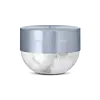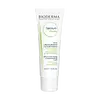What's inside
What's inside
 Key Ingredients
Key Ingredients

 Benefits
Benefits

 Concerns
Concerns

 Ingredients Side-by-side
Ingredients Side-by-side

Water
Skin ConditioningGlycerin
HumectantPentylene Glycol
Skin ConditioningSqualane
EmollientGlyceryl Stearate
EmollientSesamum Indicum Seed Oil
EmollientRaphanus Sativus Seed Extract
Skin ConditioningTaraxacum Officinale Rhizome/Root Extract
Skin ConditioningWithania Somnifera Root Extract
Skin ConditioningChlorella Vulgaris Extract
Skin ConditioningNelumbo Nucifera Flower Extract
Skin ConditioningRosmarinus Officinalis Leaf Extract
AntimicrobialButyrospermum Parkii Butter
Skin ConditioningMaris Aqua
HumectantSodium Hyaluronate
HumectantSaccharide Isomerate
HumectantFructose
HumectantHelianthus Annuus Seed Oil
EmollientHydrolyzed Algin
Sodium Stearoyl Glutamate
CleansingDimethicone
EmollientCetearyl Alcohol
EmollientAcacia Senegal Gum
MaskingXanthan Gum
EmulsifyingCarbomer
Emulsion StabilisingPhenylpropanol
MaskingTocopherol
AntioxidantTetrasodium Glutamate Diacetate
Sodium Citrate
BufferingCitric Acid
BufferingSodium Hydroxide
BufferingSodium Chloride
MaskingPotassium Sorbate
PreservativeSodium Benzoate
MaskingCitronellol
PerfumingLinalool
PerfumingLimonene
PerfumingGeraniol
PerfumingHydroxycitronellal
PerfumingHexyl Cinnamal
PerfumingAlpha-Isomethyl Ionone
PerfumingBenzyl Alcohol
PerfumingParfum
MaskingWater, Glycerin, Pentylene Glycol, Squalane, Glyceryl Stearate, Sesamum Indicum Seed Oil, Raphanus Sativus Seed Extract, Taraxacum Officinale Rhizome/Root Extract, Withania Somnifera Root Extract, Chlorella Vulgaris Extract, Nelumbo Nucifera Flower Extract, Rosmarinus Officinalis Leaf Extract, Butyrospermum Parkii Butter, Maris Aqua, Sodium Hyaluronate, Saccharide Isomerate, Fructose, Helianthus Annuus Seed Oil, Hydrolyzed Algin, Sodium Stearoyl Glutamate, Dimethicone, Cetearyl Alcohol, Acacia Senegal Gum, Xanthan Gum, Carbomer, Phenylpropanol, Tocopherol, Tetrasodium Glutamate Diacetate, Sodium Citrate, Citric Acid, Sodium Hydroxide, Sodium Chloride, Potassium Sorbate, Sodium Benzoate, Citronellol, Linalool, Limonene, Geraniol, Hydroxycitronellal, Hexyl Cinnamal, Alpha-Isomethyl Ionone, Benzyl Alcohol, Parfum
Water
Skin ConditioningGlycerin
HumectantParaffinum Liquidum
EmollientEthylhexyl Palmitate
EmollientDipropylene Glycol
HumectantXylitol
HumectantBis-PEG/PPG-16/16 PEG/PPG-16/16 Dimethicone
EmollientSodium Acrylate/Sodium Acryloyldimethyl Taurate Copolymer
Emulsion StabilisingIsohexadecane
EmollientCaprylic/Capric Triglyceride
MaskingGlycyrrhetinic Acid
Skin ConditioningTocopheryl Acetate
AntioxidantPolysorbate 80
EmulsifyingDisodium EDTA
Allantoin
Skin ConditioningFructooligosaccharides
HumectantMannitol
HumectantPropylene Glycol
HumectantCetrimonium Bromide
AntimicrobialCeramide NP
Skin ConditioningRhamnose
HumectantGinkgo Biloba Leaf Extract
Skin ConditioningDodecyl Gallate
AntioxidantLaminaria Ochroleuca Extract
Skin ConditioningParfum
MaskingWater, Glycerin, Paraffinum Liquidum, Ethylhexyl Palmitate, Dipropylene Glycol, Xylitol, Bis-PEG/PPG-16/16 PEG/PPG-16/16 Dimethicone, Sodium Acrylate/Sodium Acryloyldimethyl Taurate Copolymer, Isohexadecane, Caprylic/Capric Triglyceride, Glycyrrhetinic Acid, Tocopheryl Acetate, Polysorbate 80, Disodium EDTA, Allantoin, Fructooligosaccharides, Mannitol, Propylene Glycol, Cetrimonium Bromide, Ceramide NP, Rhamnose, Ginkgo Biloba Leaf Extract, Dodecyl Gallate, Laminaria Ochroleuca Extract, Parfum
 Reviews
Reviews

Ingredients Explained
These ingredients are found in both products.
Ingredients higher up in an ingredient list are typically present in a larger amount.
Glycerin is already naturally found in your skin. It helps moisturize and protect your skin.
A study from 2016 found glycerin to be more effective as a humectant than AHAs and hyaluronic acid.
As a humectant, it helps the skin stay hydrated by pulling moisture to your skin. The low molecular weight of glycerin allows it to pull moisture into the deeper layers of your skin.
Hydrated skin improves your skin barrier; Your skin barrier helps protect against irritants and bacteria.
Glycerin has also been found to have antimicrobial and antiviral properties. Due to these properties, glycerin is often used in wound and burn treatments.
In cosmetics, glycerin is usually derived from plants such as soybean or palm. However, it can also be sourced from animals, such as tallow or animal fat.
This ingredient is organic, colorless, odorless, and non-toxic.
Glycerin is the name for this ingredient in American English. British English uses Glycerol/Glycerine.
Learn more about GlycerinParfum is a catch-all term for an ingredient or more that is used to give a scent to products.
Also called "fragrance", this ingredient can be a blend of hundreds of chemicals or plant oils. This means every product with "fragrance" or "parfum" in the ingredients list is a different mixture.
For instance, Habanolide is a proprietary trade name for a specific aroma chemical. When used as a fragrance ingredient in cosmetics, most aroma chemicals fall under the broad labeling category of “FRAGRANCE” or “PARFUM” according to EU and US regulations.
The term 'parfum' or 'fragrance' is not regulated in many countries. In many cases, it is up to the brand to define this term.
For instance, many brands choose to label themselves as "fragrance-free" because they are not using synthetic fragrances. However, their products may still contain ingredients such as essential oils that are considered a fragrance by INCI standards.
One example is Calendula flower extract. Calendula is an essential oil that still imparts a scent or 'fragrance'.
Depending on the blend, the ingredients in the mixture can cause allergies and sensitivities on the skin. Some ingredients that are known EU allergens include linalool and citronellol.
Parfum can also be used to mask or cover an unpleasant scent.
The bottom line is: not all fragrances/parfum/ingredients are created equally. If you are worried about fragrances, we recommend taking a closer look at an ingredient. And of course, we always recommend speaking with a professional.
Learn more about ParfumWater. It's the most common cosmetic ingredient of all. You'll usually see it at the top of ingredient lists, meaning that it makes up the largest part of the product.
So why is it so popular? Water most often acts as a solvent - this means that it helps dissolve other ingredients into the formulation.
You'll also recognize water as that liquid we all need to stay alive. If you see this, drink a glass of water. Stay hydrated!
Learn more about Water